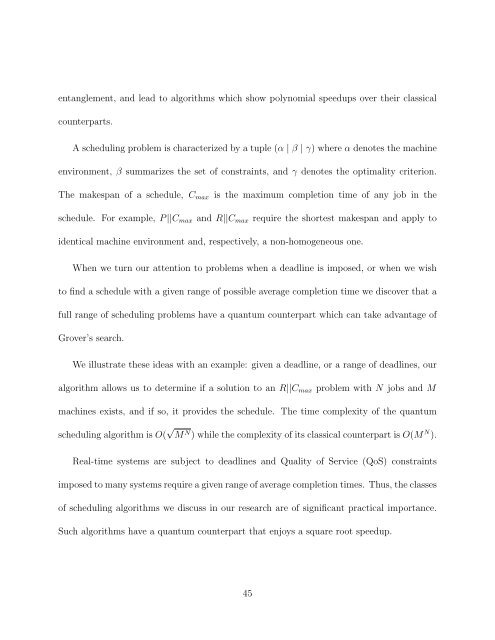t b a b a
t b a b a
t b a b a
You also want an ePaper? Increase the reach of your titles
YUMPU automatically turns print PDFs into web optimized ePapers that Google loves.
entanglement, and lead to algorithms which show polynomial speedups over their classical<br />
counterparts.<br />
A scheduling problem is characterized by a tuple (α | β | γ) where α denotes the machine<br />
environment, β summarizes the set of constraints, and γ denotes the optimality criterion.<br />
The makespan of a schedule, Cmax is the maximum completion time of any job in the<br />
schedule. For example, P ||Cmax and R||Cmax require the shortest makespan and apply to<br />
identical machine environment and, respectively, a non-homogeneous one.<br />
When we turn our attention to problems when a deadline is imposed, or when we wish<br />
to find a schedule with a given range of possible average completion time we discover that a<br />
full range of scheduling problems have a quantum counterpart which can take advantage of<br />
Grover’s search.<br />
We illustrate these ideas with an example: given a deadline, or a range of deadlines, our<br />
algorithm allows us to determine if a solution to an R||Cmax problem with N jobs and M<br />
machines exists, and if so, it provides the schedule. The time complexity of the quantum<br />
scheduling algorithm is O( √ M N ) while the complexity of its classical counterpart is O(M N ).<br />
Real-time systems are subject to deadlines and Quality of Service (QoS) constraints<br />
imposed to many systems require a given range of average completion times. Thus, the classes<br />
of scheduling algorithms we discuss in our research are of significant practical importance.<br />
Such algorithms have a quantum counterpart that enjoys a square root speedup.<br />
45

















